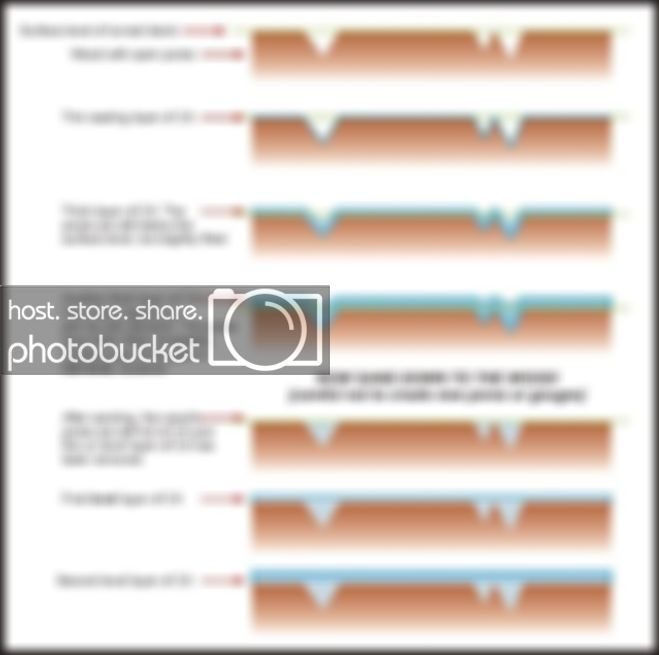JimGo
Member
I recenly did a large batch of pens, and one thing I "re-learned" was the importance of sanding sealer (I use thin CA) to producing a glossy finish. I know this is something most of you know pretty well, but I thought I'd underscore it for any new turners out there.
As we all know, wood can be seen as a series of interconnected fibers, and in between the fibers there are small holes. These are the "pores" or "openings" in the grain. If you put a finish on top of the wood without sealing the grain, the finish will stand up high on the individual fibers, but will fall down into the pores. Harkening back to highschool science class, the angle of incidence on incoming light equals the angle of reflection, which is a fancy way of saying that the light won't reflect as well off the resulting pitted surface, and your result is a matte finish. If, however, you take the time to fill the pores with a sanding sealer first, you'll get a smoother surface upon which to place your finish, and ultimately a shinier finish. Of course, after you apply your sanding sealer, you have to sand the sanding sealer off of the wood fibers (leaving it only in the pores), otherwise you have the same problem as I just described!
To enhance the efficacy of the sanding sealer, some here use a sanding "slurry" technique, in which the sanding sealer is applied at the same time some sandpaper is being applied to the blank. This creates a slurry, or thick liquid, that contains both the sanding sealer and some sanding dust. This thick, dusty liquid can help fill the open grain and leave a more natural appearance than just sanding sealer on its own. One thing I noticed is that even after applying a few coats of sanding sealer and sanding them down, you might have a surface you THINK is flat, only to find some smaller pits when you move to the higher grit sandpapers. I found that to achieve a high-gloss finish, multiple coats of sanding sealer should be applied, preferably at different grits</u>. It's been a while since I read Fangar's description of how he does his finishes, but I think that's what he said many months ago, and I probably could have saved myself a few hours of work had I just gone back and re-read his thread. And, in fact, I think Russ Fairfield may have said something like this too...but I can be a little dense at times.
Any way, I wanted to pass this along for those who are still struggling to get a high-gloss finish. If, on the otherhand, you prefer a more matte finish, skipping some or all of the sanding sealer steps can produce a really nice matte or semi-gloss finish.
I also had a question for DBRISKI. In another thread, you mentioned:
That's a GREAT idea, and would probably have saved me a lot of time with some Wenge with which I struggled over the weekend. How do you keep the glue out of the tubes during the soaking?
As we all know, wood can be seen as a series of interconnected fibers, and in between the fibers there are small holes. These are the "pores" or "openings" in the grain. If you put a finish on top of the wood without sealing the grain, the finish will stand up high on the individual fibers, but will fall down into the pores. Harkening back to highschool science class, the angle of incidence on incoming light equals the angle of reflection, which is a fancy way of saying that the light won't reflect as well off the resulting pitted surface, and your result is a matte finish. If, however, you take the time to fill the pores with a sanding sealer first, you'll get a smoother surface upon which to place your finish, and ultimately a shinier finish. Of course, after you apply your sanding sealer, you have to sand the sanding sealer off of the wood fibers (leaving it only in the pores), otherwise you have the same problem as I just described!
To enhance the efficacy of the sanding sealer, some here use a sanding "slurry" technique, in which the sanding sealer is applied at the same time some sandpaper is being applied to the blank. This creates a slurry, or thick liquid, that contains both the sanding sealer and some sanding dust. This thick, dusty liquid can help fill the open grain and leave a more natural appearance than just sanding sealer on its own. One thing I noticed is that even after applying a few coats of sanding sealer and sanding them down, you might have a surface you THINK is flat, only to find some smaller pits when you move to the higher grit sandpapers. I found that to achieve a high-gloss finish, multiple coats of sanding sealer should be applied, preferably at different grits</u>. It's been a while since I read Fangar's description of how he does his finishes, but I think that's what he said many months ago, and I probably could have saved myself a few hours of work had I just gone back and re-read his thread. And, in fact, I think Russ Fairfield may have said something like this too...but I can be a little dense at times.
Any way, I wanted to pass this along for those who are still struggling to get a high-gloss finish. If, on the otherhand, you prefer a more matte finish, skipping some or all of the sanding sealer steps can produce a really nice matte or semi-gloss finish.
I also had a question for DBRISKI. In another thread, you mentioned:
...What I usually do is rough it, bring it within a hair of finished sized, take it off the lathe, soak it in thin CA, let that dry completely. Put it back on the lathe, sand off the extra CA, put on a couple coats of thick CA (and BLO if you wish) to fill the pores, sand down to finish size and finish as you prefer.
That's a GREAT idea, and would probably have saved me a lot of time with some Wenge with which I struggled over the weekend. How do you keep the glue out of the tubes during the soaking?


